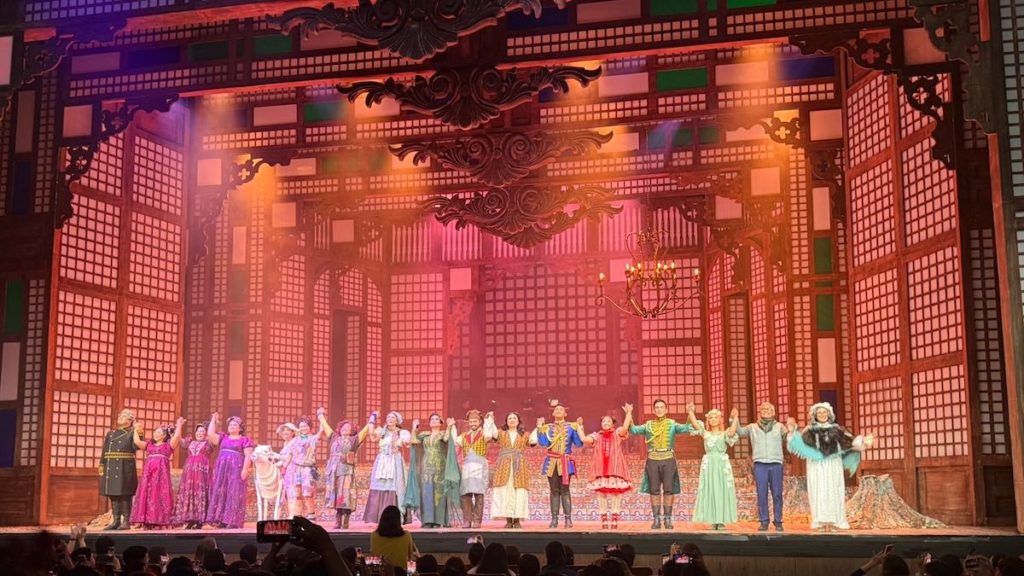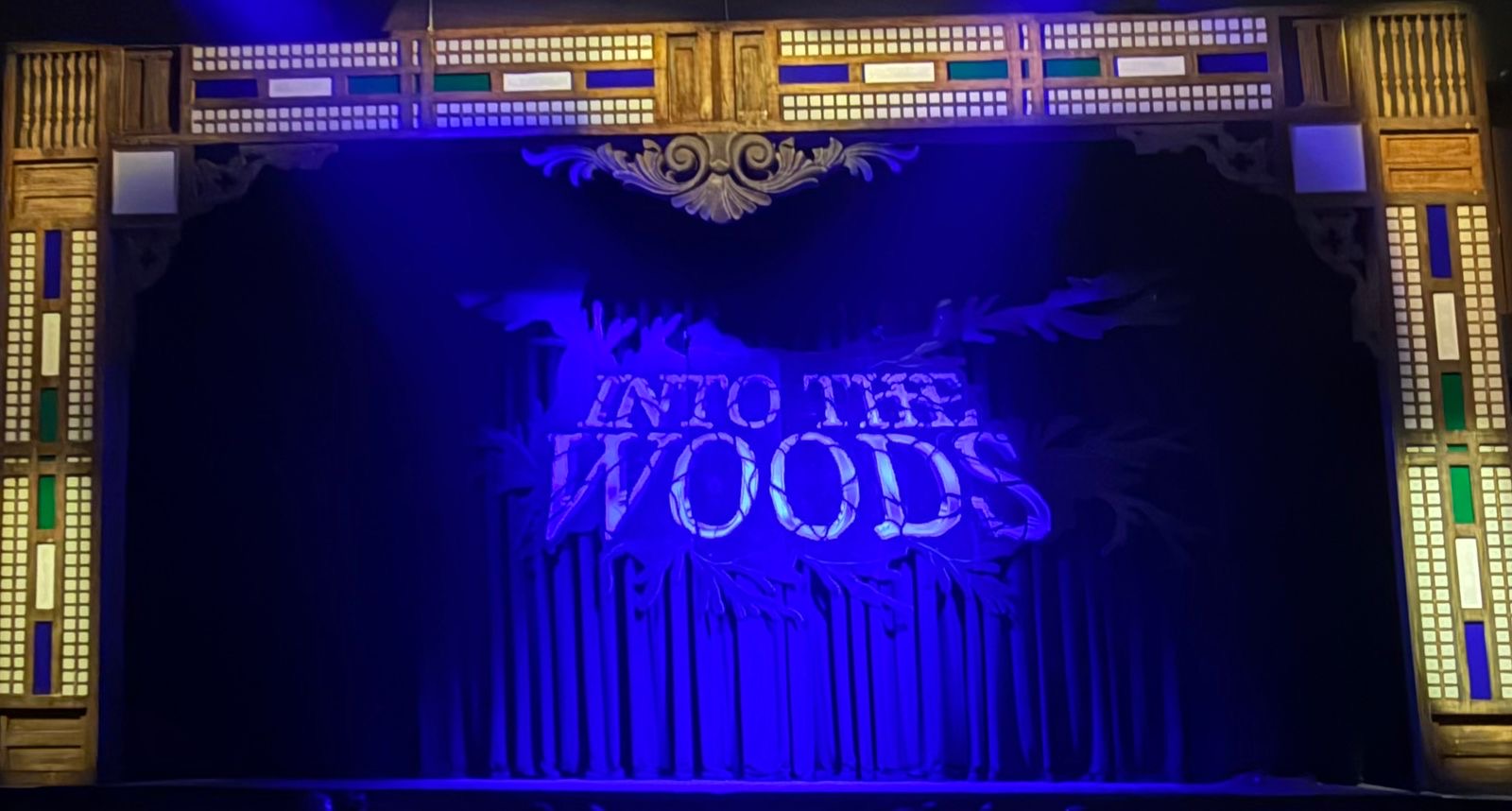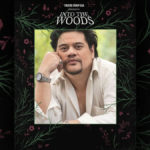When Theater Group Asia under co-founder Clint Ramos announced their take on Stephen Sondheim’s beloved masterpiece, Into the Woods, a buzz of anticipation filled the air at the Samsung Performing Arts Theater at Circuit, Makati. Unfortunately, the production ultimately proved that it’s possible to miss the woods for the trees even with what some would call a bulletproof property—an ironic and disappointing commentary on a show that so clearly states its intentions.

What Happens When Wishes Come True?
Directed by Chari Arespacochaga, Into the Woods presents a whimsical tapestry of classic fairy tales, following a baker and his wife (Nyoy Volante and Mikkie Bradshaw-Volante) on their quest to reverse a witch’s (Lea Salonga) curse. To do so, they must go into the woods to gather specific items and find themselves in the process. The narrative, however, is not a simple “happily ever after” story. The first act is a whirlwind of frantic quests and interweaving plots as our heroes—Cinderella (Arielle Jacobs), Jack (of beanstalk fame, played by Nic Chien), Little Red Riding Hood (Teetin Villanueva), and the baker and his wife—triumphantly secure their desires, each believing their wishes are finally granted. However, the second act reveals the messy, complicated fallout of these victories. The musical explores the heavy reality that even after getting what you want, you’re still left with the complex truth of who you are and where you’re going.
A Disconnected Visual Identity
The set and costume design (Ohm David and Raven Ong, respectively), with its dominance of capiz windows and indigenous fabrics, felt entirely detached from the story itself. While these elements are beautiful on their own, they served no narrative purpose, adding a layer of visual noise that felt more like a distraction than an enhancement. Production design should work in harmony with the story, a visual language that amplifies the themes and emotional journey of the characters. Here, it felt like a jarring, often bizarre juxtaposition.
The unfortunate result of this superficial flavoring is a textbook case of Filipino-washing, a form of cultural baiting that leverages recognizable Filipino visuals and accents without any real depth or understanding. It’s a dangerous practice, as it reduces a rich and diverse culture to mere set dressing—a decorative accessory to an otherwise western narrative. This approach not only insults the intelligence of an audience but also perpetuates harmful stereotypes, reinforcing the idea that Filipino identity is nothing more than a collection of aesthetic clichés. The danger lies in its pretense: it offers the illusion of inclusivity and representation while clearly and actively undermining genuine cultural storytelling. In the end, what you’re left with is an empty spectacle that trades authenticity for cheap, tokenized appeal.
The Heart of the Show
The cast, as a whole, is a major highlight, with several performers delivering truly standout work. Jacobs is a pitch-perfect Cinderella, so fully inhabiting the role that one hopes to see her in a future Broadway revival of this very show. Salonga delivers a Witch with strong vocals and such deep emotional nuance and pathos. The delightful Villanueva makes a funny and charming Little Red Riding Hood, while Bradshaw-Volante gives an endearing and earnest performance as the Baker’s Wife. These four performers are the pillars that held up the show, and as a result, served as a testament to the power of a great cast to make a show shine.
As one of Stephen Sondheim’s most popular and beloved masterpieces, this version becomes a victim of its own legacy. As the show progresses, a discordant truth emerges: the weight of the entire production eventually rested squarely on the shoulders of this select few. Tasked with elevating a complicated score and plot amidst baffling artistic choices, some members of the cast had to pull double-duty to ensure the story stays afloat. With every scene, Jacobs, Salonga, Villanueva, and Bradshaw-Volante pour their hearts into a vision that is, at best, inconsistent and, at worst, downright bizarre. Through sheer force of talent and will, they manage to find moments of truth and brilliance under layers of over-produced fluff, proving that even a compromised masterpiece is, at the very least, still an opportunity to execute a masterful performance.
When Talent Transcends The Problems of an Imperfect Vision
Frankly, the audience deserved a better-produced show—one that was thoughtfully and authentically staged. But they didn’t get that. Instead, they got a flawed production that, by its very nature, exposed a powerful truth: that the uncompromising talent and sheer dedication of the cast were what truly mattered in the end. Fairy tales are popular precisely because the lessons they teach—about wishes, about loss, about the messiness of life after “happily ever after”—are fundamentally universal. The core emotions of Into the Woods transcends borders, and the production’s greatest failure was its apparent lack of faith in this simple truth and the ability of the average Filipino theatergoer to grasp these concepts.
It’s a failure of imagination, believing it had to pander to its audience with superficial Filipino iconography. This talented ensemble, however, understood the assignment. For all the production’s flaws and missed opportunities for genuine cultural representation, the cast proved that the value of a great musical can’t be so easily underestimated. It is a triumphant, if bittersweet, testament to artists who, through sheer dedication, honored the soul of the work even when the production around them spectacularly collapsed into irrelevance.
Visit PalabasTayo.com for more stories on film, TV, music, theater, art, fashion, food and other general lifestyle and entertainment topics like this. You may also follow and subscribe to our social media accounts: Facebook, YouTube, Instagram, TikTok, X, and Kumu.






















